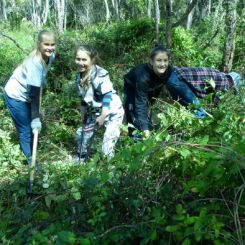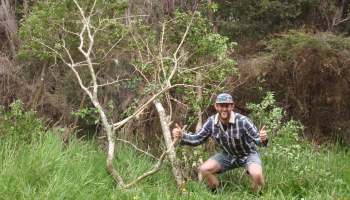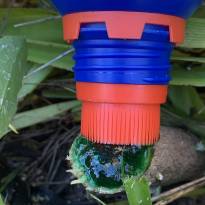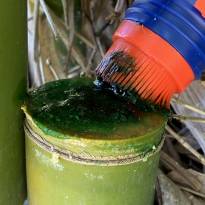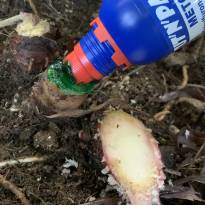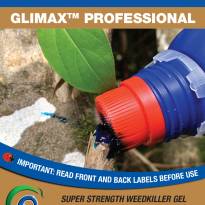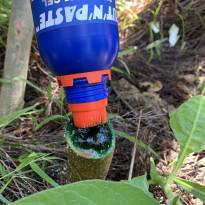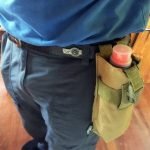Weeds can teach you a lot
By Anna Elwarth, Community Ranger.
The Hilltop School Weedbuster Story
Tackling a reserve of weeds with 80 pairs of young energetic hands was genius enough. To then have the multi-layered learning potential revealed to Taupō Hilltop School teacher Collette Taylor was a bonus.

Hilltop School Weedbusters
“I was tackling weeds in a conservation reserve in my neighbourhood by myself in the weekends, saddened by how little I was achieving, and daunted by what was needed to be done, when the idea first dawned on me of viewing my class of students as a resource of energy to tap into,” says Ms Taylor.
An army of year 7 and 8 classes geared with loppers, secateurs and ‘Cut n Paste’ herbicide gel was a formidable force to fight the War on Weeds as Weedbusters. All in a day’s work, the kids put big holes in walls of weeds such as broome, cotoneaster and carpets of tradescantia. Since 2013, the students have cleared the equivalent of three rugby fields of weeds in the Oruatua Conservation Reserve near the Tauranga-Taupō River.
“Little did I know then that that idea would turn into a 3-year curriculum-linked programme and would become part of the culture of the school and bring such a sense of pride. Some of the most valuable learnings for the students were about character building.”
Surprise lessons were in stamina, stickability, team work, giving back to the community, keeping fit and the mental benefits of being outdoors and in nature. Student Samuel Richardson said busting weeds is like doing homework. “Sometimes we don’t enjoy doing it but the outcome is for the greater good.”
The students learnt that you just can’t weed and walk away. The piles of weeds have to be removed or they regrow, areas cleared have to be planted with native tress to prevent re-infestation, and the new trees have to be watered and protected from rabbits.
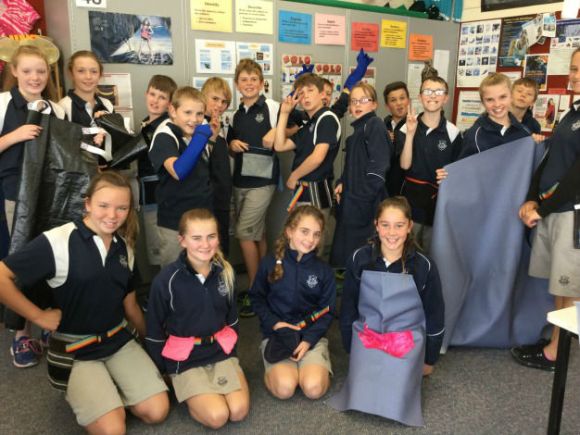
Fun with technology solutions to weedbusting problems
Technology fit for purpose
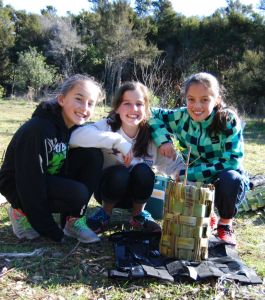
Biodegradable tree protectors keep the rabbits out
The students created solutions to their weed busting challenges in their technology class. Student Grace Davies explains that mats and wagons helped carry the dead weeds, they sewed heavy-duty tool belts and gaiters. “It was a long way to drag the weeds to the trailer so it was really satisfying to see other students using them, making the job easier.”
They made predator traps using their wood-work skills and learnt to make QR codes so that passers-by could inform them if they had caught something in their trap.
For Tauhara College technology teacher Fiona Holdsworth, a learning highlight was harvesting and using harakeke from the reserve, and then weaving it into plant protectors and weed mats that would biodegrade. “This was a lesson in completing the lifecycle taken from the land, repurposed, and returned to the area as a protective role,” she explained.

Parents chipping in with the wood-chipper
The more the merrier

Local Weedbusters Karen Ardin and Shirley Potter inspired to join in
Spreading the word about not spreading weeds has been another branch to the project. The students wrote posters on why weed busting is important and have placed one in the petrol station window adjacent to the reserve. They also did a presentation at a youth environment expo and ran their own blog site which their families could follow.
Many parents joined the working bees helping with everything from the chopping and dragging to running wood chippers and post hole borers. Even the bus driver brought old clothes and picked up tools. Many more parents would have heard about the day’s adventures over the family meal, and seen weeds pulled from backyards.
Locals have rallied to the effort. Project Tongariro members and Oruatua residents Shirley Potter and Karen Ardin, who also have their own weed war a few metres upstream, join in the working bees. Project Tongariro bought a scrub bar from local shop Turangi Chainsaws and Mowers which gave them a great price and generously donated a chainsaw. On the job, Shirley powers ahead with a good health and safety lead and the energetic youth clear the carnage.
“The amount of work they can get through in a day is fantastic!” she says. “Having young people leading this kind of work is good news for the environment.” Local Ian Jenkins raised native plants and donated them to the project. Local business Wairakei Estate also dontated trees, as have Project Tongariro.
The cost of conservation
It is much easier to raise money for a cute fluffy kākāpō chick, but a lot harder to find money for clearing weeds. Although the schools were successful in formal funding rounds such as $5000 from the O-I Environmental fund of Recycle Glass NZ, many of the parents and their businesses also came forward and the school was able to buy their own set of tools and cover the cost of bussing the students the 40 kilometres from school to the reserve.
Reaping what you sow
Being rewarded for hard work is a joyful and proud lesson in life. Impressed by the hard work and sustainability of this program, the Hilltop School Weedbusters won the Tongariro Taupō Conservation Board award for school project in 2015. One of the classes attended a local kiwi release learning more about the benefits of conservation, and the benefits of our flora and fauna being in ecological balance.
On the last working bee for 2016 the kererū were singing from the flowering kōwhai – singing a big thank you to the rolling generations of the Hilltop weed busting students!

Teachers Collette Taylor and Alan Murphy, and students accepting their conservation award
Weedbusters is a weeds awareness and education programme that aims to protect New Zealand’s environment from the increasing weed problem. For more information, visit the Weedbusters website.
No Comments
Be the first to start the conversation!



